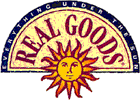Case Studies Check out Real Goods
third DPO!
Real Goods Trading Corporation
John Schaeffer started this catalog
direct marketing business with a $3,000 investment in 1986 and still owned it all five
years later when we started its first DPO. Half of its $6 million annual sales at that
time were in alternative energy generation (photovoltaic, wind and hydro) systems and
energy conservation. The rest were in a broad range of environmental, "green"
products.
A brief description of Real Goods in the Wall Street
Journal's Enterprise column suggested that it might fit the elements in the
"Screen Test for a Direct Public Offering." The first edition of this book was
about to be published and the next step was to carry what had been developed in the
savings bank DPOs over to other industries. John was willing to test the concept and to
use the new SCOR filing process for offerings of not more than $1 million.
Real Goods selected a target market of customers who had
purchased more than a certain amount, or more than three times, in the most recent 15
months. These were sorted by residence and 13 states were picked for the offering, based
upon the number of qualified customers and the cost of compliance with state securities
laws. A "tombstone" announcement went to 15,000 customers in October 1991.
Within three months, there had been 6,200 requests for the offering documents and sales to
674 new shareowners. Another $300,000 had to be returned to 175 customers who subscribed
after the maximum had been reached.
A second DPO was completed in 1993, using the SEC's
Regulation A filing and simply updating the offering document from the earlier SCOR
offering. This time, the $3,600,000 maximum amount was sold and several hundred thousand
dollars had to be returned as coming in too late. After the two offerings, John Schaeffer
still owned 75% of the Company. Shares began trading on the Pacific Stock Exchange in 1994
and over-the-counter trading is reported on the NASDAQ Small Cap Market. In 1996, Real
Goods became the first company to begin an SEC-cleared bulletin board for
"off-the-grid" buying and selling its shares without a broker.
Three securities brokerage firms were enlisted on a
"best efforts" agency basis for the second offering. However, their total sales
were less than 10% of the offering. We also experimented with ways to identify and
communicate with affinity groups beyond Real Goods customers. Most of those were not
cost-effective.
Real Goods had learned after its first offering that
customers who had become shareowners purchased twice the dollar amount of Real Goods
products than non-shareowner customers. The extra contribution to gross profit was well
worth the cost of servicing shareowners with reports and certificates. As a result, the
minimum required purchase was reduced from 100 shares to 15 shares in the second offering.
The states in which we registered the offering was increased to 44. Nearly 5,000 Real
Goods customers had become shareowners in the two DPOs, with an average investment of
about $900. Total costs of the two offerings, including marketing expenses, had been about
ten percent of the funds raised. |
